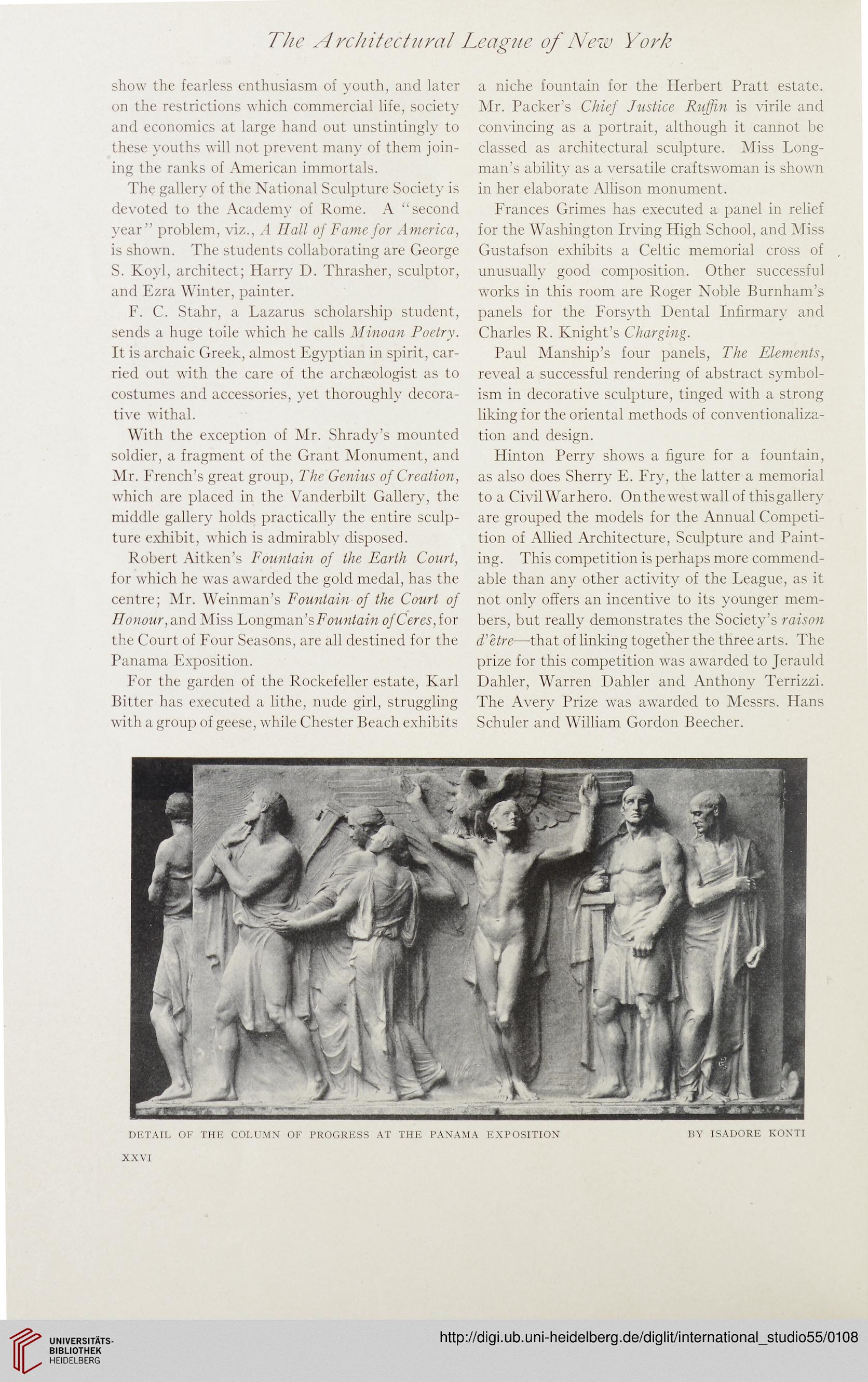The Architectural League of New York
show the fearless enthusiasm of youth, and later
on the restrictions which commercial life, society
and economics at large hand out unstintingly to
these youths will not prevent many of them join-
ing the ranks of American immortals.
The gallery of the National Sculpture Society is
devoted to the Academy of Rome. A “second
year” problem, viz., A Hall of Fame for America,
is shown. The students collaborating are George
S. Koyl, architect; Harry D. Thrasher, sculptor,
and Ezra Winter, painter.
F. C. Stahr, a Lazarus scholarship student,
sends a huge toile which he calls Minoan Poetry.
It is archaic Greek, almost Egyptian in spirit, car-
ried out with the care of the archaeologist as to
costumes and accessories, yet thoroughly decora-
tive withal.
With the exception of Mr. Shrady’s mounted
soldier, a fragment of the Grant Monument, and
Mr. French’s great group, The Genius of Creation,
which are placed in the Vanderbilt Gallery, the
middle gallery holds practically the entire sculp-
ture exhibit, which is admirably disposed.
Robert Aitken’s Fountain of the Earth Court,
for which he was awarded the gold medal, has the
centre; Mr. Weinman’s Fountain of the Court of
Honour,axui Miss Longman’s Fountain of Ceres, for
the Court of Four Seasons, are all destined for the
Panama Exposition.
For the garden of the Rockefeller estate, Karl
Bitter has executed a lithe, nude girl, struggling
with a group of geese, while Chester Beach exhibits
a niche fountain for the Herbert Pratt estate.
Mr. Packer’s Chief Justice Ruffin is virile and
convincing as a portrait, although it cannot be
classed as architectural sculpture. Miss Long-
man’s ability as a versatile craftswoman is shown
in her elaborate Allison monument.
Frances Grimes has executed a panel in relief
for the Washington Irving High School, and Miss
Gustafson exhibits a Celtic memorial cross of
unusually good composition. Other successful
works in this room are Roger Noble Burnham’s
panels for the Forsyth Dental Infirmary and
Charles R. Knight’s Charging.
Paul Manship’s four panels, The Elements,
reveal a successful rendering of abstract symbol-
ism in decorative sculpture, tinged with a strong
liking for the oriental methods of conventionaliza-
tion and design.
Hinton Perry shows a figure for a fountain,
as also does Sherry E. Fry, the latter a memorial
to a Civil War hero. Onthewestwall of thisgallery
are grouped the models for the Annual Competi-
tion of Allied Architecture, Sculpture and Paint-
ing. This competition is perhaps more commend-
able than any other activity of the League, as it
not only offers an incentive to its younger mem-
bers, but really demonstrates the Society’s raison
d'etre—-that of linking together the three arts. The
prize for this competition was awarded to Jerauld
Dahler, Warren Dahler and Anthony Terrizzi.
The Avery Prize was awarded to Messrs. Hans
Schuler and William Gordon Beecher.
DETAIL OF THE COLUMN OF PROGRESS AT THE PANAMA EXPOSITION
BY ISADORE KONTI
XXVI
show the fearless enthusiasm of youth, and later
on the restrictions which commercial life, society
and economics at large hand out unstintingly to
these youths will not prevent many of them join-
ing the ranks of American immortals.
The gallery of the National Sculpture Society is
devoted to the Academy of Rome. A “second
year” problem, viz., A Hall of Fame for America,
is shown. The students collaborating are George
S. Koyl, architect; Harry D. Thrasher, sculptor,
and Ezra Winter, painter.
F. C. Stahr, a Lazarus scholarship student,
sends a huge toile which he calls Minoan Poetry.
It is archaic Greek, almost Egyptian in spirit, car-
ried out with the care of the archaeologist as to
costumes and accessories, yet thoroughly decora-
tive withal.
With the exception of Mr. Shrady’s mounted
soldier, a fragment of the Grant Monument, and
Mr. French’s great group, The Genius of Creation,
which are placed in the Vanderbilt Gallery, the
middle gallery holds practically the entire sculp-
ture exhibit, which is admirably disposed.
Robert Aitken’s Fountain of the Earth Court,
for which he was awarded the gold medal, has the
centre; Mr. Weinman’s Fountain of the Court of
Honour,axui Miss Longman’s Fountain of Ceres, for
the Court of Four Seasons, are all destined for the
Panama Exposition.
For the garden of the Rockefeller estate, Karl
Bitter has executed a lithe, nude girl, struggling
with a group of geese, while Chester Beach exhibits
a niche fountain for the Herbert Pratt estate.
Mr. Packer’s Chief Justice Ruffin is virile and
convincing as a portrait, although it cannot be
classed as architectural sculpture. Miss Long-
man’s ability as a versatile craftswoman is shown
in her elaborate Allison monument.
Frances Grimes has executed a panel in relief
for the Washington Irving High School, and Miss
Gustafson exhibits a Celtic memorial cross of
unusually good composition. Other successful
works in this room are Roger Noble Burnham’s
panels for the Forsyth Dental Infirmary and
Charles R. Knight’s Charging.
Paul Manship’s four panels, The Elements,
reveal a successful rendering of abstract symbol-
ism in decorative sculpture, tinged with a strong
liking for the oriental methods of conventionaliza-
tion and design.
Hinton Perry shows a figure for a fountain,
as also does Sherry E. Fry, the latter a memorial
to a Civil War hero. Onthewestwall of thisgallery
are grouped the models for the Annual Competi-
tion of Allied Architecture, Sculpture and Paint-
ing. This competition is perhaps more commend-
able than any other activity of the League, as it
not only offers an incentive to its younger mem-
bers, but really demonstrates the Society’s raison
d'etre—-that of linking together the three arts. The
prize for this competition was awarded to Jerauld
Dahler, Warren Dahler and Anthony Terrizzi.
The Avery Prize was awarded to Messrs. Hans
Schuler and William Gordon Beecher.
DETAIL OF THE COLUMN OF PROGRESS AT THE PANAMA EXPOSITION
BY ISADORE KONTI
XXVI




